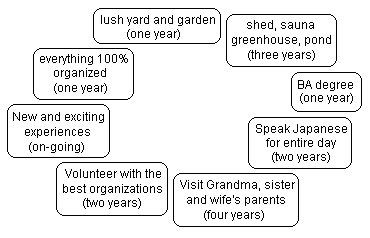 A few days ago I saw the latest issue of Natural Home Magazine, which mentioned Jay Shafer, who owns a tiny home. A little more research convinced me that I want to build a bunch of small buildings. While a shipping container might be the right size and good in many other respects, it also has toxic components and is not decomposable; once set in place it is very difficult to alter or move. I want something that is organic, that can grow into position, blend into its surroundings, and peacefully decay just as quickly. Solve et coagula. I also want something that reflects my labor of love, that is a work of art first and a functional shelter second. I even would give it a title like all great artwork deserves. I would call it "shelter" or more abstractly "how to survive a drought". All my artwork is created at little or no expense, partly because I am naturally frugal, and partly because I do not want to spend a lot of money on something that I don't really need and may not care for anyway. What form of shelter can I make that is small, decomposable, artful and cheap? I reconsidered the relatively labor intensive grindbygg, which had lately fallen into disfavor due to the greater flexibility of frame construction methods.
A few days ago I saw the latest issue of Natural Home Magazine, which mentioned Jay Shafer, who owns a tiny home. A little more research convinced me that I want to build a bunch of small buildings. While a shipping container might be the right size and good in many other respects, it also has toxic components and is not decomposable; once set in place it is very difficult to alter or move. I want something that is organic, that can grow into position, blend into its surroundings, and peacefully decay just as quickly. Solve et coagula. I also want something that reflects my labor of love, that is a work of art first and a functional shelter second. I even would give it a title like all great artwork deserves. I would call it "shelter" or more abstractly "how to survive a drought". All my artwork is created at little or no expense, partly because I am naturally frugal, and partly because I do not want to spend a lot of money on something that I don't really need and may not care for anyway. What form of shelter can I make that is small, decomposable, artful and cheap? I reconsidered the relatively labor intensive grindbygg, which had lately fallen into disfavor due to the greater flexibility of frame construction methods.One of the challenges I face regardless of what I build is that at any location on my lot the ground is sloping to a greater or lesser degree and in no where is it flat. This increases complexity of the foundation. One of the advantages of the grindbygg is that it relies on a series of vertical posts to support the compressive weight of the roof, each of which can be cut to any length to adjust to the changing elevation of the plot it sits on, a different kind of foundation from the typical frame building. These posts are completely enclosed within the structure, protecting them from the effects of the weather. Posts and beams are very heavy, however if I make the shortest of the posts only three feet tall, then the grindbygg so constructed will still retain many of its advantages while being easier to erect. Such a building could serve as a modest shed, the first so built being a test of my ideas. I will need to buy a chainsaw to build with or I would soon lose hope of completing the project. A grindbygg can be small, decomposable, artful and cheap. The challenge is to complete this potentially time consuming project within one summer. I may need to use Wally Wallington's methods to erect the frames.
I like a grindbygg for all the functions that its form allows. Here is very useful see through picture I found recently.
